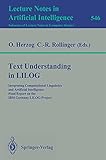Text Understanding in LILOG [electronic resource] : Integrating Computational Linguistics and Artificial Intelligence Final Report on the IBM Germany LILOG-Project / edited by Otthein Herzog, Claus-Rainer Rollinger.
Material type: TextSeries: Lecture Notes in Computer Science, Lecture Notes in Artificial Intelligence ; 546Publisher: Berlin, Heidelberg : Springer Berlin Heidelberg, 1991Description: XII, 744 p. online resourceContent type: text Media type: computer Carrier type: online resourceISBN: 9783540384939Subject(s): Computer science | Software engineering | Database management | Artificial intelligence | Computer Science | Artificial Intelligence (incl. Robotics) | Mathematical Logic and Formal Languages | Database Management | Programming Techniques | Software EngineeringAdditional physical formats: Printed edition:: No titleDDC classification: 006.3 LOC classification: Q334-342TJ210.2-211.495Online resources: Click here to access online
TextSeries: Lecture Notes in Computer Science, Lecture Notes in Artificial Intelligence ; 546Publisher: Berlin, Heidelberg : Springer Berlin Heidelberg, 1991Description: XII, 744 p. online resourceContent type: text Media type: computer Carrier type: online resourceISBN: 9783540384939Subject(s): Computer science | Software engineering | Database management | Artificial intelligence | Computer Science | Artificial Intelligence (incl. Robotics) | Mathematical Logic and Formal Languages | Database Management | Programming Techniques | Software EngineeringAdditional physical formats: Printed edition:: No titleDDC classification: 006.3 LOC classification: Q334-342TJ210.2-211.495Online resources: Click here to access online  E-BOOKS
E-BOOKS
| Current library | Home library | Call number | Materials specified | URL | Status | Date due | Barcode |
|---|---|---|---|---|---|---|---|
| IMSc Library | IMSc Library | Link to resource | Available | EBK4503 |
Introducing LILOG -- Text understanding — The challenges to come -- A formalism for natural language — STUF -- The language of STUF -- Chart-parsing of STUF grammars -- The STUF workbench -- Unification-ID/LP grammars: Formalization and parsing -- A flexible parser for a Linguistic Development Environment -- Gap-Handling mechanisms in categorial grammars -- Outlines of the LEU/2 lexicology -- Morphological processing in the two-level paradigm -- Representing word meanings -- Sortal information in lexical concepts -- Incremental vocabulary extensions in text understanding systems -- Managing lexical knowledge in LEU/2 -- The grammars of LILOG -- An alternative phrase structure account of symmetric coordination -- Verb order and head movement -- The Bermuda Triangle: Natural language semantics between linguistics, knowledge representation, and knowledge processing -- Presupposition, anaphora, and lexical content -- Anaphora and domain restriction -- On representing the temporal structure of texts -- The treatment of plurality in L LILOG -- The knowledge representation language LLILOG -- Knowledge packets and knowledge packet structures -- Deductive aspects of three-valued logic -- The LILOG inference engine -- Knowledge based control of the LILOG inference engine: Kinds of metaknowledge -- Attributive description formalisms ... and the rest of the world -- The background knowledge of the LILOG system -- The LILOG ontology from a linguistic point of view -- A knowledge engineering environment for LILOG -- Knowledge engineering in the context of related fields of research -- LILOG-DB: Database support for knowledge based systems -- Processing of spatial expressions in LILOG -- Phenomena of localization -- Verbs of motion and position: On the optionality of the local argument -- Why a hill can't be a valley: Representing gestalt and position properties of objects with object schemata -- Object-oriented representation of depictions on the basis of cell matrices -- Integrating a generation component into a natural language understanding system -- From knowledge structures to text structures -- The formulator -- Constructing a context for LEU/2 -- The text understanding system LEU/2 -- The trace of building a large AI system.
The IBM project LILOG presented in this volume represents a fundamental stepbeyond computer science as hitherto understood. It was a successful project in every respect and has shed light on conjectured basic interrelations between knowledge processing and language definition. Knowledge processing is strongly coupled to the natural language used, and for applied knowledge processing an information base is neededwhich defines the semantic contents and interrelations of the language. The LILOG project was an implementation of an information basein the German language. A set of tools was also developed to work with the system, including structured man-machine interfaces using natural language, inference algorithms, and a complete subsystem to acquire and store the required knowledge. The LILOG project started in 1985 and a functional system was demonstrated in 1991. The project involved approximately 200 of the scientists working in Germany in the fields of computational linguistics, natural language understanding systems, and artificial intelligence. The project proves that a cooperative project between universities and industry can produce useful results both in pure research and in implemented methods and tools.


There are no comments on this title.